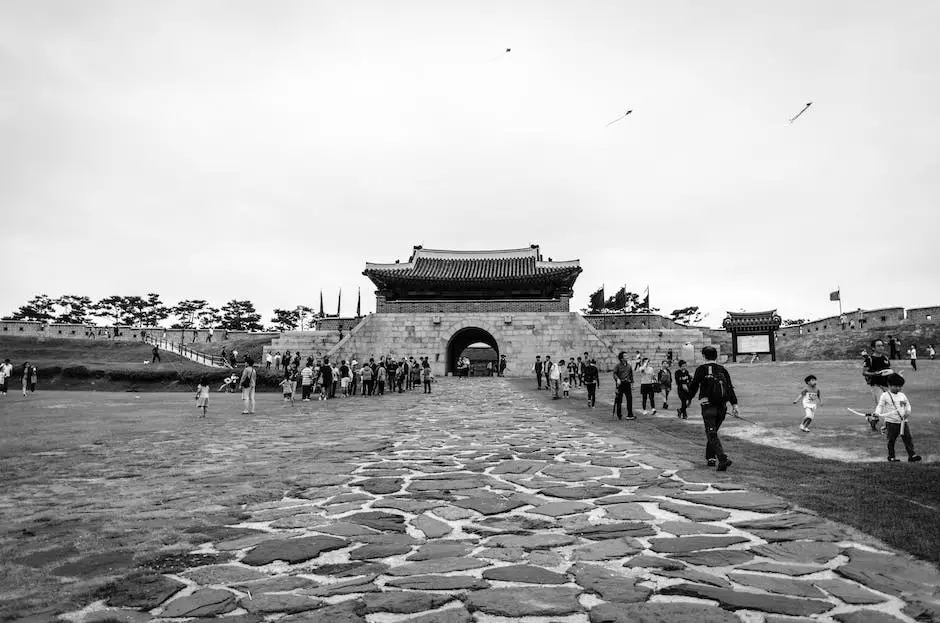
Nestled in the heart of South Korea, Suwon is a city where the past and present collide, creating a tapestry of architectural marvels that tell tales of history, culture, and innovation. As I meander through its streets, I can’t help but be captivated by the seamless blend of ancient structures and modern designs that make Suwon a living museum of architectural evolution.
The Roots of Suwon’s Architectural Heritage
The story of Suwon’s architecture begins with Hwaseong Fortress, a UNESCO World Heritage site that stands as a testament to the city’s historical significance. Constructed in the late 18th century under the reign of King Jeongjo, this fortress encapsulates the ingenuity of Joseon Dynasty military architecture. Its massive walls, intricate Gates, and strategic towers were not only defensive features but also symbols of the king’s vision for a new political and cultural epicenter.
Walking along the ramparts of Hwaseong Fortress, I’m struck by the meticulous craftsmanship. The use of bricks and stones, laid with precision, has withstood the test of time, showcasing the Joseon era’s architectural prowess. It’s a humbling reminder of how the past lays the groundwork for the future.
Transitioning Through Time: Suwon’s Modernization
Fast forward to the 20th century, and Suwon began to embrace modernity. The city’s growth was spurred by industrialization, leading to a surge in urban development. Residential and commercial buildings sprouted, reflecting contemporary styles and the necessities of a booming population. Yet, amidst this transformation, Suwon’s architects and planners maintained a reverence for their heritage, ensuring new constructions harmonized with historical landmarks.
One can’t help but admire the juxtaposition of old and new as traditional hanok houses sit alongside sleek, glass-fronted buildings. This blend of styles speaks volumes about the city’s ability to adapt while honoring its roots.
Innovation Meets Tradition: Contemporary Suwon Architecture
Today, Suwon is a hub of architectural innovation. The Galleria Department Store, with its futuristic facade, is a prime example. Its undulating glass exterior reflects the city’s skyline, a symbol of Suwon’s dynamic spirit. Yet, even in such cutting-edge designs, there’s a nod to tradition, with motifs and elements that pay homage to the city’s historical narrative.
Public spaces in Suwon also reflect this marriage of old and new. The Suwon Convention Center, for instance, is a modern facility that caters to international events while drawing inspiration from the fluidity and openness of traditional Korean architecture. It’s a place where global and local cultures converge, much like the city itself.
Green Spaces and Sustainable Design
In recent years, Suwon has taken strides towards sustainability. The city’s architects are not just building structures; they’re crafting eco-friendly environments. Green roofs, energy-efficient designs, and smart city initiatives are becoming the norm. Suwon’s commitment to green architecture is evident in projects like the Gwanggyo Lake Park, where nature and urban living coexist harmoniously.
As I stroll through this verdant oasis, I’m reminded that architecture isn’t just about buildings; it’s about creating spaces that enhance the quality of life for its inhabitants. Suwon’s green initiatives are a breath of fresh air, literally and figuratively.
Preservation and Revitalization: Keeping History Alive
While Suwon continues to evolve, there’s a concerted effort to preserve its architectural heritage. Restoration projects like those at Hwaseong Fortress ensure that historical structures are not only maintained but also integrated into the fabric of contemporary life. These efforts bridge the gap between generations, allowing both residents and visitors to appreciate the city’s storied past.
Revitalization isn’t just about maintaining old buildings; it’s about repurposing them to meet modern needs. Old factories and warehouses are being transformed into cultural spaces, art galleries, and community centers. This adaptive reuse breathes new life into once-forgotten structures, making history relevant and accessible.
FAQs
- What makes Suwon’s architecture unique?
Suwon’s architecture is a unique blend of historical structures like Hwaseong Fortress and modern designs that incorporate traditional elements and sustainable practices. This fusion creates a distinctive urban landscape that respects the past while embracing the future.
- How has Suwon’s architecture changed over the years?
From the Joseon Dynasty’s military fortifications to contemporary green buildings, Suwon’s architecture has evolved to reflect the city’s growth, technological advancements, and commitment to sustainability.
- Can visitors experience Suwon’s architectural heritage easily?
Absolutely! Suwon is very accessible to visitors, with guided tours of Hwaseong Fortress and other historical sites, as well as walks through modern districts showcasing the city’s architectural diversity.
Conclusion
In conclusion, Suwon’s architecture is a living chronicle of South Korea’s journey from past to present. The city’s landscape is a harmonious blend of historical treasures and contemporary marvels, each telling its own story while contributing to a collective narrative. From the sturdy walls of Hwaseong Fortress to the eco-conscious designs of modern buildings, Suwon exemplifies how cities can honor their heritage while forging ahead into a sustainable future.
As we’ve explored, Suwon’s commitment to preserving its past, coupled with its embrace of innovation, makes it a fascinating case study in architectural evolution. For anyone interested in the intersection of history and modernity, Suwon offers a compelling glimpse into the possibilities of urban development done right. It’s a city that has managed to grow without losing sight of where it came from, ensuring that its architectural legacy will continue to inspire for generations to come.
For those of us who cherish both history and progress, Suwon stands as a shining example of how the two can coexist beautifully. It’s a city that doesn’t just build structures; it builds bridges—between eras, cultures, and people. And that, my friends, is the true beauty of Suwon’s architecture.